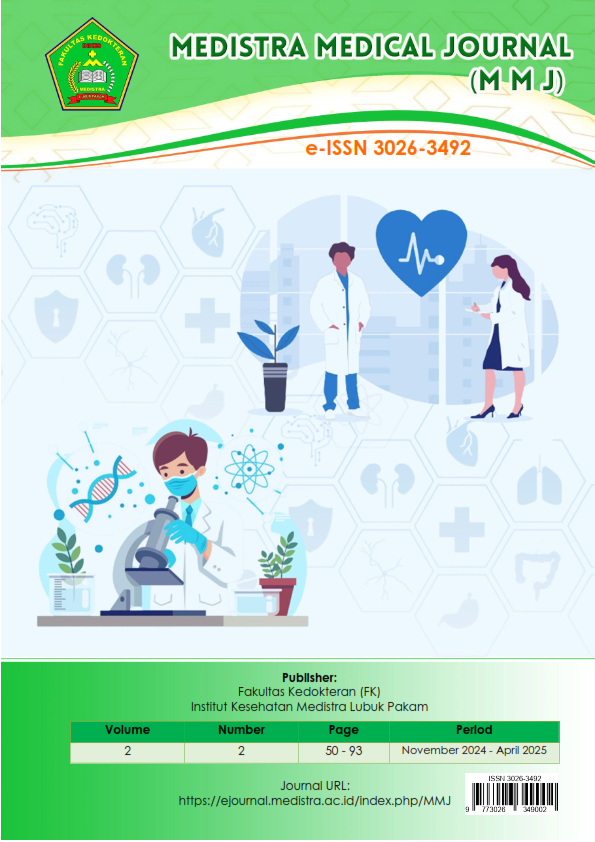Effectiveness of the Medical Command System in Catastrophic Emergency Response at Grandmed Hospital Lubuk Pakam and Sembiring General Hospital Delitua in 2023
DOI:
https://doi.org/10.35451/nn8sc508Keywords:
Sistem Komando Medis; Bencana; Rumah Sakit; Kesiapsiagaan; KegawatdaruratanAbstract
Background: The Medical Command System (MCS) is a crucial mechanism in hospital disaster management to ensure effective coordination, communication, and resource allocation. This study aimed to evaluate the effectiveness of the MCS in catastrophic emergency response at Grandmed Hospital Lubuk Pakam and Sembiring General Hospital Delitua in 2023. Methods: This study employed a descriptive quantitative design with a survey approach. Data were collected using questionnaires covering indicators of coordination, communication, and resource allocation. Respondents consisted of healthcare workers involved in hospital disaster response teams. Results: The findings revealed that the effectiveness of MCS implementation reached 85% at Grandmed Hospital and 77.7% at Sembiring General Hospital. Grandmed Hospital demonstrated better preparedness in logistics and command structure, while Sembiring Hospital faced challenges in communication facilities and emergency logistics availability. Key barriers included limited communication infrastructure, lack of routine simulations, and suboptimal staff training. Conclusion: The MCS was proven effective in supporting catastrophic emergency response in both hospitals. However, further improvement in communication systems, disaster simulation, and emergency logistics management is needed to strengthen hospital disaster preparedness.
References
[1] Ariani, M., Donna, B., Pangaribuan, H., Yogadhita, G., & Wartatmo, H. (2023). Hospital Preparedness in Facing the COVID-19 Pandemic Based on the Command System: A Study in Jakarta and Yogyakarta, Indonesia. Prehospital and Disaster Medicine. Cambridge University Press & Assessment.
[2] BNPB. (2021). Pedoman Sistem Komando Penanganan Darurat Bencana. Badan Nasional Penanggulangan Bencana.
[3] Chuang, S., Woods, D. D., Reynolds, M., Ting, H.-W., Balkin, A., et al. (2021). Rethinking preparedness planning in disaster emergency care: Lessons from a beyond-surge-capacity event. World Journal of Emergency Surgery, 16, Article 59. BioMed Central.
[4] Dhamanti, I., etc. (2025). The impact of hospital surge capacity during the 2009 H1N1 pandemic: A systematic study. [Journal Name]. Taylor & Francis Online.
[5] Fathoni, M., & Nurhidayati, T. (2021). Implementasi sistem komando insiden dalam penanggulangan bencana di rumah sakit. Jurnal Manajemen Bencana, 7(2), 115–124. https://doi.org/10.22146/jmb.2021.115
[6] Guner, R., Hasanoglu, I., & Aktas, F. (2020). Emergency management of disaster and mass casualty incidents. Turkish Journal of Emergency Medicine, 20(4), 147–153. https://doi.org/10.4103/2452-2473.298423
[7] Hasan, M. K., et al. (2022). Hospital Surge Capacity Preparedness in Disasters and Emergencies: A Systematic Review. MDPI. PMC.
[8] Kementerian Kesehatan RI. (2020). Pedoman Kesiapsiagaan Rumah Sakit dalam Menghadapi Bencana. Jakarta: Kemenkes RI.
[9] Lestari, F., Paramitasari, D., Fatmah, Yani Hamid, A., Suparni, EL-Matury, H. J., Wijaya, O., Rahmadani, M., Ismiyati, A., Firdausi, R. A., et al. (2022). Analysis of Hospital’s Emergency and Disaster Preparedness Using Hospital Safety Index in Indonesia. Sustainability, 14(10), 5879. MDPI.
[10] Maharani, R. (2022). Evaluasi kesiapsiagaan rumah sakit dalam menghadapi bencana menggunakan Hospital Disaster Plan. Jurnal Administrasi Rumah Sakit Indonesia, 8(1), 33–42. https://doi.org/10.7454/jarsi.v8i1.42
[11] Pratama, Y., & Lestari, D. (2021). Sistem komando medis dalam manajemen bencana di fasilitas kesehatan. Jurnal Kesehatan Masyarakat Andalas, 15(2), 55–63. https://doi.org/10.25077/jkma.15.2.55-63.2021
[12] Schull, M. J., et al. (2006). Hospital Surge Capacity: If You Can’t Always Get What You Want. PMC.
[13] Setiawan, D. (Year). Studi kasus kesiapan Rumah Sakit Haji Jakarta berbasis sistem komando darurat dan struktur HICS. [Tesis/Disertasi/Artikel UIN Jakarta].
[14] Shafiei, A., Arsalani, N., Beyrami Jam, M., et al. (2024). The impact of surge capacity enhancement training for nursing managers on hospital disaster preparedness and response: An action research study. BMC Emergency Medicine, 24, Article 153. BioMed Central.
[15] Use of Incident Command System for Disaster Preparedness: A Model for an Emergency Department COVID-19 Response. Disaster Medicine and Public Health Preparedness. Cambridge University Press.
[16] Utami, Y. P. D., Pinzon, R. T., & Meliala, A. (2021). Studi kasus kesiapan rumah sakit Bethesda Yogyakarta dalam menghadapi lonjakan pasien COVID-19: Surge capacity dan incident command system. Jurnal Kebijakan Kesehatan Indonesia, 10(2), 100-110. Jurnal UGM
[17] WHO. (2020). Hospital emergency response checklist: An all-hazards tool for hospital administrators and emergency managers. World Health Organization. https://apps.who.int/iris/handle/10665/151639
[18] Yuliana, S., & Handayani, R. (2022). Analisis pelatihan dan simulasi bencana terhadap kesiapsiagaan tenaga kesehatan di rumah sakit. Jurnal Keperawatan dan Kebencanaan, 5(1), 21–30. https://doi.org/10.22219/jkkb.v5i1.2022
[19] Iksen I, Kemila MA, Hutabarat NI, Latif AR, Irma R, Luhurningtyas FP, Nainggolan DR, Mustiqawati E, Marbun RA. Interaksi Obat: Obat-obat, Obat-Makanan Pegangan Pada Praktik Klinis. Yayasan Kita Menulis; 2023 May 15
Downloads
Published
Issue
Section
License
Copyright (c) 2025 Dicky Yuswardi Wiratma

This work is licensed under a Creative Commons Attribution 4.0 International License.
Copyright in each article is the property of the Author.
















